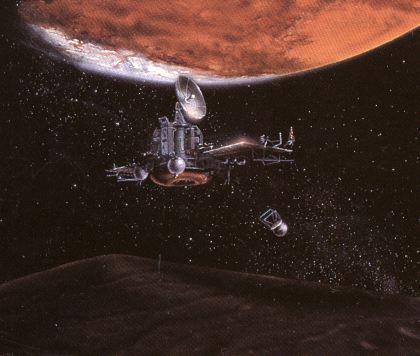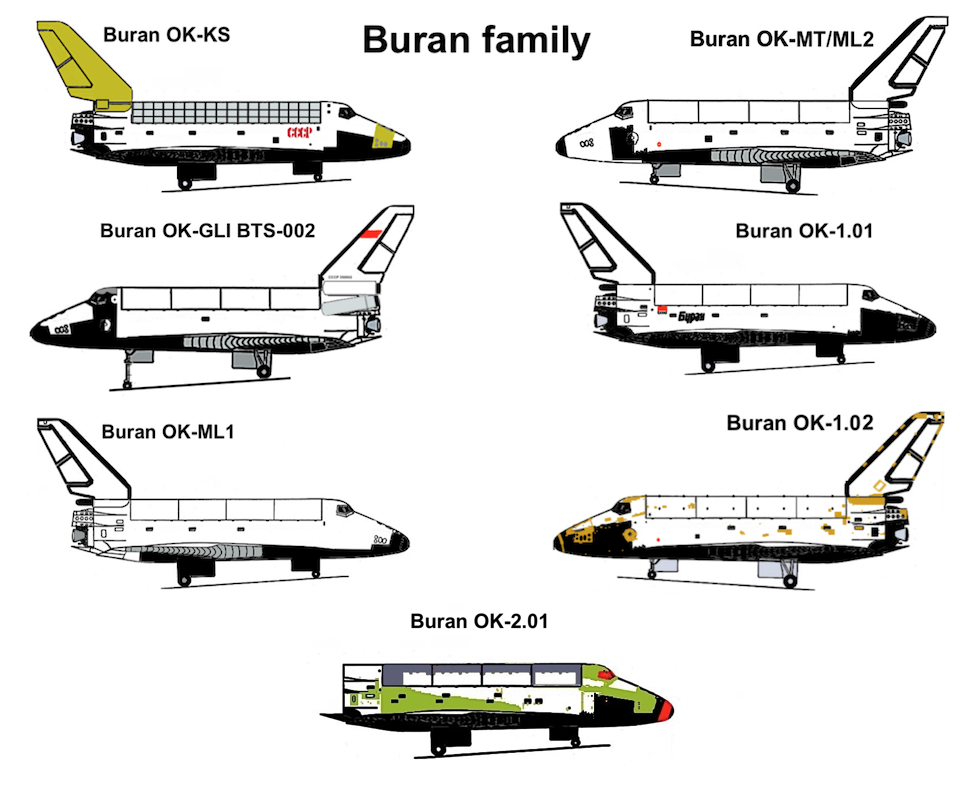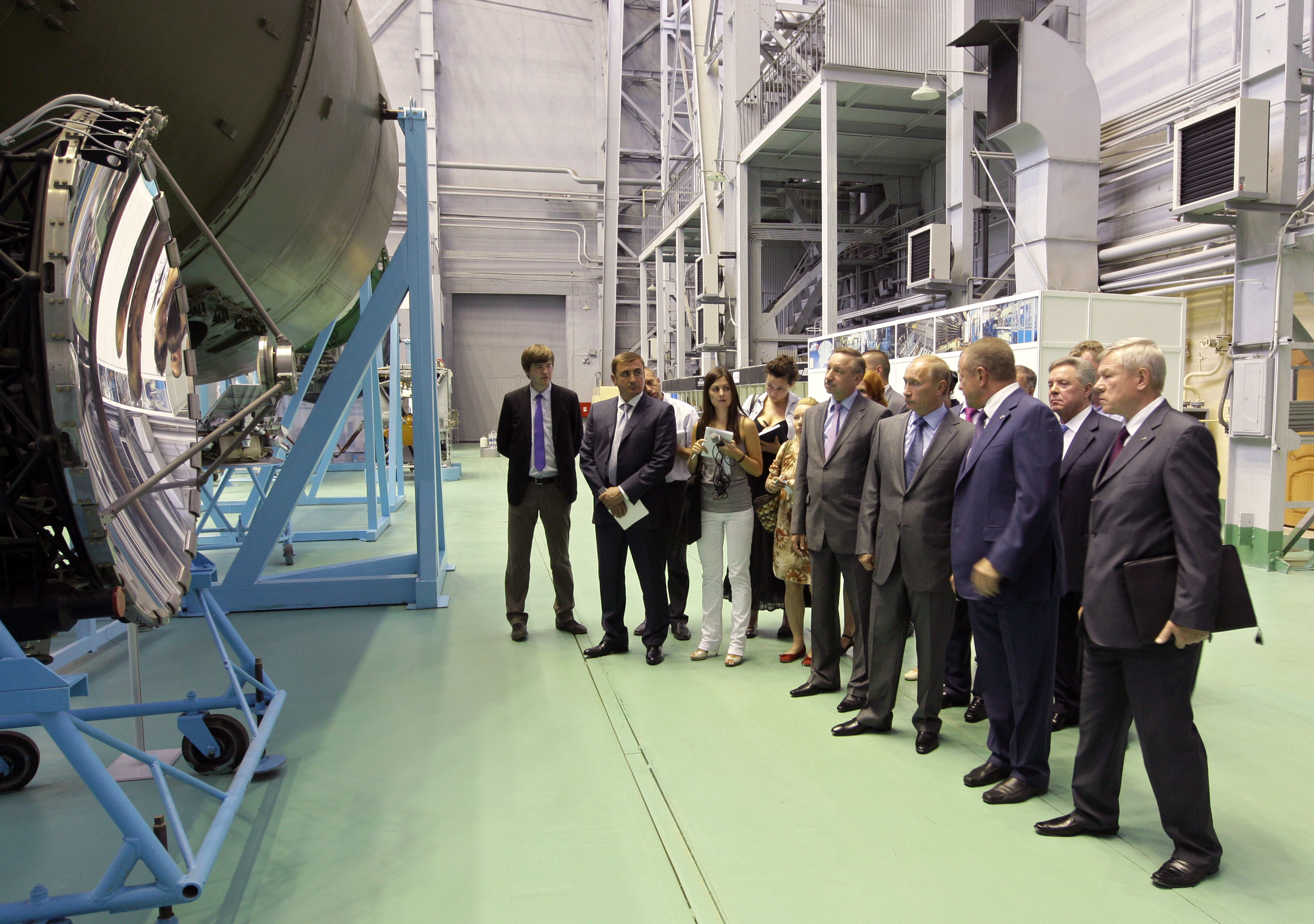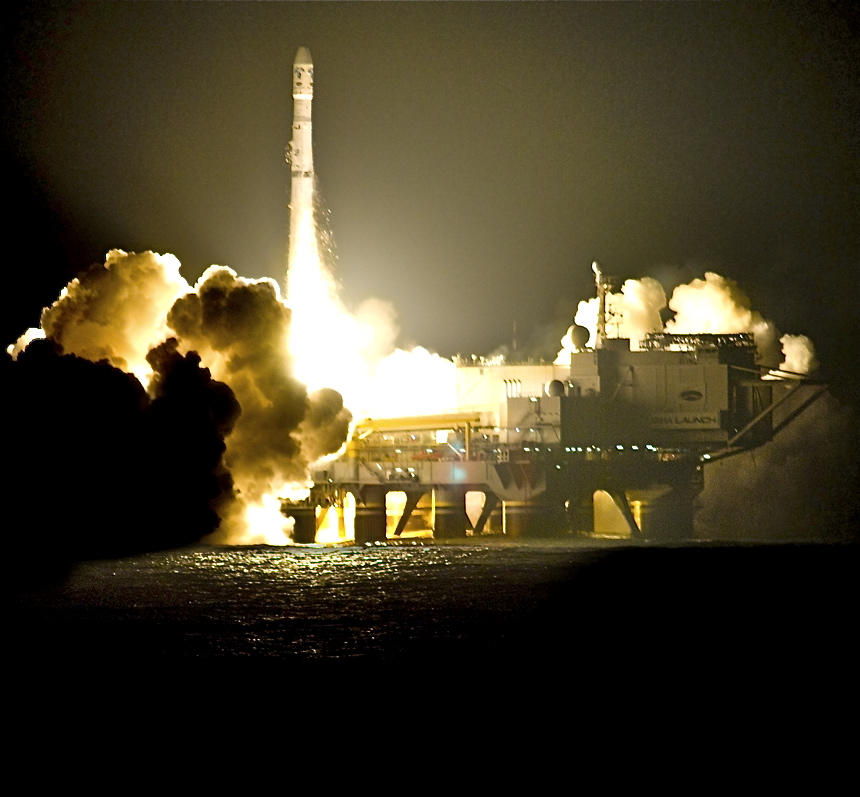|
Blok D
Blok D (russian: Блок Д meaning Block D) is an upper stage used on Soviet and later Russian expendable launch systems, including the N1, Proton-K and Zenit. The stage (and its derivatives) has been included in more than 320 launched rockets . By 2002 its modification Blok DM had a 97% success rate in 218 flights since 1974, and 43 successful missions in 1997–2002. The stage was developed in 1960s as the fifth stage (' Д' is the fifth letter in the Cyrillic alphabet) for the Soviet Moonshot N1 rocket. The stage first flew in March 1967 while testing Zond of the moonshot program system. During manned lunar flight Blok D would be used for mid-course corrections on the flight to the Moon, then to place the lunar orbiter and lander into a lunar orbit, and decelerate moon-lander out onto its landing trajectory. Blok D was also included as fourth stage of Proton-K and as such flew on unmanned Soviet missions to Moon, Mars ( Mars 3) and Venus. It was used in the Prot ... [...More Info...] [...Related Items...] OR: [Wikipedia] [Google] [Baidu] |
Soviet Union
The Soviet Union,. officially the Union of Soviet Socialist Republics. (USSR),. was a List of former transcontinental countries#Since 1700, transcontinental country that spanned much of Eurasia from 1922 to 1991. A flagship communist state, it was nominally a Federation, federal union of Republics of the Soviet Union, fifteen national republics; in practice, both Government of the Soviet Union, its government and Economy of the Soviet Union, its economy were highly Soviet-type economic planning, centralized until its final years. It was a one-party state governed by the Communist Party of the Soviet Union, with the city of Moscow serving as its capital as well as that of its largest and most populous republic: the Russian Soviet Federative Socialist Republic, Russian SFSR. Other major cities included Saint Petersburg, Leningrad (Russian SFSR), Kyiv, Kiev (Ukrainian Soviet Socialist Republic, Ukrainian SSR), Minsk (Byelorussian Soviet Socialist Republic, Byelorussian SSR), Tas ... [...More Info...] [...Related Items...] OR: [Wikipedia] [Google] [Baidu] |
Mars
Mars is the fourth planet from the Sun and the second-smallest planet in the Solar System, only being larger than Mercury. In the English language, Mars is named for the Roman god of war. Mars is a terrestrial planet with a thin atmosphere (less than 1% that of Earth's), and has a crust primarily composed of elements similar to Earth's crust, as well as a core made of iron and nickel. Mars has surface features such as impact craters, valleys, dunes and polar ice caps. It has two small and irregularly shaped moons, Phobos and Deimos. Some of the most notable surface features on Mars include Olympus Mons, the largest volcano and highest known mountain in the Solar System and Valles Marineris, one of the largest canyons in the Solar System. The Borealis basin in the Northern Hemisphere covers approximately 40% of the planet and may be a large impact feature. Days and seasons on Mars are comparable to those of Earth, as the planets have a similar rotation period a ... [...More Info...] [...Related Items...] OR: [Wikipedia] [Google] [Baidu] |
Fobos 2
''Phobos 2'' was the last space probe designed by the Soviet Union. It was designed to explore the moons of Mars, Phobos and Deimos. It was launched on 12 July 1988, and entered orbit on 29 January 1989. ''Phobos 2'' operated nominally throughout its cruise and Mars orbital insertion phases on 29 January 1989, gathering data on the Sun, interplanetary medium, Mars, and Phobos. ''Phobos 2'' investigated Mars surface and atmosphere and returned 37 images of Phobos with a resolution of up to 40 meters. Shortly before the final phase of the mission, during which the spacecraft was to approach within of Phobos' surface and release two landers (One, a mobile , the other, a stationary platform) contact with ''Phobos 2'' was lost. The mission ended when the spacecraft signal failed to be successfully reacquired on 27 March 1989. The cause of the failure was determined to be a malfunction of the on-board computer. Background The intent to carry out a mission with Phobos as the targ ... [...More Info...] [...Related Items...] OR: [Wikipedia] [Google] [Baidu] |
Fobos 1
''Phobos 1'' was an uncrewed Soviet space probe of the Phobos Program launched from the Baikonour launch facility on 7 July 1988. Its intended mission was to explore Mars and its moons Phobos and Deimos. The mission failed on 2 September 1988 when a computer malfunction caused the end-of-mission order to be transmitted to the spacecraft. At the time of launch it was the heaviest interplanetary spacecraft ever launched, weighing . Background The intent to carry out a mission with Phobos as the target was first made public 14 November 1984. Phobos was chosen as the target in order to avoid directly competing with previous American missions. Originally a 1986 launch was planned but this later moved to 1988. Flight plan It was to take an estimated 200 days for the ''Phobos 1'' space probe to travel from the Earth to Mars. Two mid-course corrections were planned. The first between days 7 and 20, and the second between day 185 and 193. These corrections would place the probe ... [...More Info...] [...Related Items...] OR: [Wikipedia] [Google] [Baidu] |
Buran (spacecraft)
''Buran'' (russian: Буран, , meaning "Snowstorm" or "Blizzard"; GRAU index serial number: 11F35 1K, construction number: 1.01) was the first spaceplane to be produced as part of the Soviet/Russian Buran program. Besides describing the first operational Soviet/Russian shuttle orbiter, "Buran" was also the designation for the entire Soviet/Russian spaceplane project and its orbiters, which were known as "Buran-class orbiters". Buran completed one uncrewed spaceflight in 1988, and was destroyed in the 2002 collapse of its storage hangar. The Buran-class orbiters used the expendable Energia rocket, a class of super heavy-lift launch vehicle. It is named after the Asian wind. Construction The construction of the Buran spacecraft began in 1980, and by 1984 the first full-scale orbiter was rolled out. Over 1000 companies all over the Soviet Union were involved in construction and development. The Buran spacecraft was made to be launched on the Soviet Union's super-heavy l ... [...More Info...] [...Related Items...] OR: [Wikipedia] [Google] [Baidu] |
RKK Energia
PAO S. P. Korolev Rocket and Space Corporation Energia (russian: Ракетно-космическая корпорация «Энергия» им. С. П. Королёва, Raketno-kosmicheskaya korporatsiya "Energiya" im. S. P. Korolyova), also known as RSC Energia (, RKK "Energiya"), is a Russian manufacturer of spacecraft and space station components. The company is the prime developer and contractor of the Russian crewed spaceflight program; it also owns a majority of Sea Launch. Its name is derived from Sergei Korolev, the first chief of its design bureau, and the Russian word for energy. Overview Energia is the largest company of the Russian space industry and one of its key players. It is responsible for all operations involving human spaceflight and is the lead developer of the Soyuz and Progress spacecraft, and the lead developer of the Russian end of the International Space Station (ISS). In the mid-2000s, the company employed 22,000–30,000 people. The en ... [...More Info...] [...Related Items...] OR: [Wikipedia] [Google] [Baidu] |
JSC Krasnoyarsk Machine-Building Plant
JSC Krasmash (stylized KrasMash), the Krasnoyarsk Machine-Building Plant (russian: Красноярский машиностроительный завод) is a company based in Krasnoyarsk, Russia and established in 1932. It is currently a Roscosmos subsidiary. The Krasnoyarsk Machine-Building Plant was a leading producer of liquid propellant submarine-launched ballistic missiles in the USSR. It has also produced "Biryusa" refrigerators for many years and in the 1990s it converted to the production of a number of new civilian goods. The company also produced the torches for the 2014 Winter Olympics torch relay. Products * R-29RM Shtil * R-29RMU Sineva * R-29RMU2 Layner * BZhRK Barguzin * Blok D Blok D (russian: Блок Д meaning Block D) is an upper stage used on Soviet and later Russian expendable launch systems, including the N1, Proton-K and Zenit. The stage (and its derivatives) has been included in more than 320 launched r ... * Blok DM-03 * RS-28 Sarmat Ref ... [...More Info...] [...Related Items...] OR: [Wikipedia] [Google] [Baidu] |
RD-58
The RD-58 (manufacturer designation 11D58) is a rocket engine, developed in the 1960s by OKB-1, now RKK Energia. The project was managed by Mikhail Melnikov, and it was based on the previous S1.5400 which was the first staged combustion engine in the world. The engine was initially created to power the Block D stage of the Soviet Union's abortive N-1 rocket. Derivatives of this stage are now used as upper stages on some Proton and Zenit rockets. An alternative version of the RD-58 chamber, featuring a shorter nozzle, was used as the N-1's roll-control engine. The RD-58 uses LOX as the oxidizer and RG-1 as fuel in an oxidizer rich staged combustion cycle. It features a single gimbaled chamber, radial centrifugal pumps with auxiliary booster pumps, and an oxygen-rich preburner. Recent modifications include a lightweight carbon-composite nozzle extender developed by NPO Iskra. The Buran spacecraft used two of an evolution of the RD-58M, called 17D12, as its main orbital co ... [...More Info...] [...Related Items...] OR: [Wikipedia] [Google] [Baidu] |
Kerosene
Kerosene, paraffin, or lamp oil is a combustible hydrocarbon liquid which is derived from petroleum. It is widely used as a fuel in aviation as well as households. Its name derives from el, κηρός (''keros'') meaning " wax", and was registered as a trademark by Canadian geologist and inventor Abraham Gesner in 1854 before evolving into a generic trademark. It is sometimes spelled kerosine in scientific and industrial usage. The term kerosene is common in much of Argentina, Australia, Canada, India, New Zealand, Nigeria, and the United States, while the term paraffin (or a closely related variant) is used in Chile, eastern Africa, South Africa, Norway, and in the United Kingdom. The term lamp oil, or the equivalent in the local languages, is common in the majority of Asia and the Southeastern United States. Liquid paraffin (called mineral oil in the US) is a more viscous and highly refined product which is used as a laxative. Paraffin wax is a waxy solid extracted from ... [...More Info...] [...Related Items...] OR: [Wikipedia] [Google] [Baidu] |
Liquid Oxygen
Liquid oxygen—abbreviated LOx, LOX or Lox in the aerospace, submarine and gas industries—is the liquid form of molecular oxygen. It was used as the oxidizer in the first liquid-fueled rocket invented in 1926 by Robert H. Goddard, an application which has continued to the present. Physical properties Liquid oxygen has a pale blue color and is strongly paramagnetic: it can be suspended between the poles of a powerful horseshoe magnet. Liquid oxygen has a density of , slightly denser than liquid water, and is cryogenic with a freezing point of and a boiling point of at . Liquid oxygen has an expansion ratio of 1:861 under and , and because of this, it is used in some commercial and military aircraft as a transportable source of breathing oxygen. Because of its cryogenic nature, liquid oxygen can cause the materials it touches to become extremely brittle. Liquid oxygen is also a very powerful oxidizing agent: organic materials will burn rapidly and energetically in ... [...More Info...] [...Related Items...] OR: [Wikipedia] [Google] [Baidu] |
Astra 1K
Astra 1K was a communications satellite manufactured by Alcatel Space for SES. When it was launched on 25 November 2002, it was the largest civilian communications satellite ever launched, with a mass of . Intended to replace the Astra 1B satellite and provide backup for 1A, 1C and 1D at the Astra 19.2°E orbital position, the Blok DM3 upper stage of the Proton-K launch vehicle failed to function properly, leaving the satellite in an unusable parking orbit. Launch Astra 1K was to be a European (Luxembourg-based) geostationary communications satellite that was launched by a Proton-K launch vehicle from Baikonur Cosmodrome at 23:04:23 UTC on 25 November 2002. However, the Blok DM3 upper stage attached to the , 13 kW satellite (reported to be the most massive of civilian communications satellite, with its 52 Ku-band and two Ka-band transponders to cover 1,100 channels) was miscommanded to separate after the first burn, resulting in the satellite orbiting at a very low or ... [...More Info...] [...Related Items...] OR: [Wikipedia] [Google] [Baidu] |
Sea Launch
Sea Launch was a multinational—Norway, Russia, Ukraine, United States—spacecraft launch company founded in 1995 that provided orbital launch services from 1999–2014. The company used a mobile maritime launch platform for equatorial launches of commercial payloads on specialized Zenit-3SL rockets from a former mobile/floating oil drilling rig renamed ''Odyssey''. By 2014, it had assembled and launched thirty-two rockets, with an additional three failures and one partial failure. All commercial payloads were communications satellites intended for geostationary transfer orbit with such customers as EchoStar, DirecTV, XM Satellite Radio, PanAmSat, and Thuraya. The approach Sea Launch LLC used was to assemble the launcher on a purpose-built ship '' Sea Launch Commander'' in Nimitz Rd., Long Beach, California, USA. The assembled spacecraft was then positioned on top of the self-propelled ''Odyssey'' floating launch platform and moved to the equatorial Pacific Ocean for ... [...More Info...] [...Related Items...] OR: [Wikipedia] [Google] [Baidu] |




.jpg)
